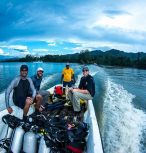DNA reveals the past and future of coral reefs
New DNA techniques are being used to understand how coral reacted to the end of the last ice age in order to better predict how they will cope with current changes to the climate. James Cook Univer

From 2005 to 2022, the main node of the ARC Centre of Excellence for Coral Reef Studies was headquartered at James Cook University in Townsville, Queensland (Australia)








Abstract. Many coral reef scientists including us spend much time underwater. Through our research, we meticulously collect data to document aspects of the natural world and the impacts of humanity on nature. However, communicating our nuanced and detailed findings to the broader public can be challenging. Photography is an extremely effective medium for conveying our research, and our emotions surrounding the natural world more broadly; indeed, many of us probably started pursuing careers in coral reef science after being inspired by the work of underwater photographers and filmmakers. Despite spending large amounts of time in photogenic places and doing interesting things, we often give little consideration to documenting our activities and subjects. In this seminar, we will provide an introduction to underwater photography. While some photographic principles apply both on land and underwater, the marine realm possesses some unique properties that should be considered when taking photographs underwater. We will cover subjects including basic photographic principles, composition, lighting, and post-processing to help you improve your underwater photography. We will also show you that you don’t need a great camera to take great pictures – but you do need to know how to get the most out of the camera you have. With communication of our research beyond the academic sphere becoming increasingly important, improving your underwater photography skills can provide a valuable tool to share your research to a broad audience.
Biography. Tom Bridge and Ed Roberts are both researchers at the ARC Centre of Excellence for Coral Reef Studies. They are also avid underwater photographers, and represent two-thirds of the team comprising the underwater photography website Tethys Images, www.tethys-images.com. After accumulating large photographic portfolios independently over many years and recognizing increased demand from scientific, government and conservation organisations, they decided to pool their resources and make their work available to a wider audience. They enjoy seeing their images used to benefit science, education and conservation of the natural environment. Their images have been featured on the covers of prestigious journals including Nature, Ecology Letters, Current Biology and Proceedings of the Royal Society B, government reports including the Australian Government’s National Marine Science Plan 2015-2025, and in public displays such as the new Cairns Aquarium.
New DNA techniques are being used to understand how coral reacted to the end of the last ice age in order to better predict how they will cope with current changes to the climate. James Cook Univer
A new study on the effects of climate change in five tropical countries has found fisheries are in more trouble than agriculture, and poor people are in the most danger. Distinguished Profess
James Cook University researchers have found brightly coloured fish are becoming increasingly rare as coral declines, with the phenomenon likely to get worse in the future. Christopher Hemingson, a
Researchers working with stakeholders in the Great Barrier Reef region have come up with ideas on how groups responsible for looking after the reef can operate more effectively when the next bleaching
Abstract: As marine species adapt to climate change, their heat tolerance will likely be under strong selection. Individual variation in heat tolerance and its heritability underpin the potential fo
Abstract: The Reef Ecology Lab in KAUST’s Red Sea Research Center explores many aspects of movement ecology of marine organisms, ranging from adult migrations to intergenerational larval dispersal
Abstract: Macroalgal meadows are a prominent, yet often maligned component of the tropical seascape. Our work at Ningaloo reef in WA demonstrate that canopy forming macroalgae provide habitat for ad
Abstract: Sharks are generally perceived as strong and fearsome animals. With fossils dating back at least 420 million years, sharks are not only majestic top predators but they also outlived dinosa
Abstract: Connectivity plays a vital role in many ecosystems through its effects on fundamental ecological and evolutionary processes. Its consequences for populations and metapopulations have been
Abstract: Evolution of many eukaryotic organisms is affected by interactions with microbes. Microbial symbioses can ultimately reflect host’s diet, habitat range, and even body shape. However, how
Abstract: The past few years have seen unprecedented coral bleaching and mortality on the Great Barrier Reef (GBR) but the consequences of this on biodiversity are not yet known. This talk will expl